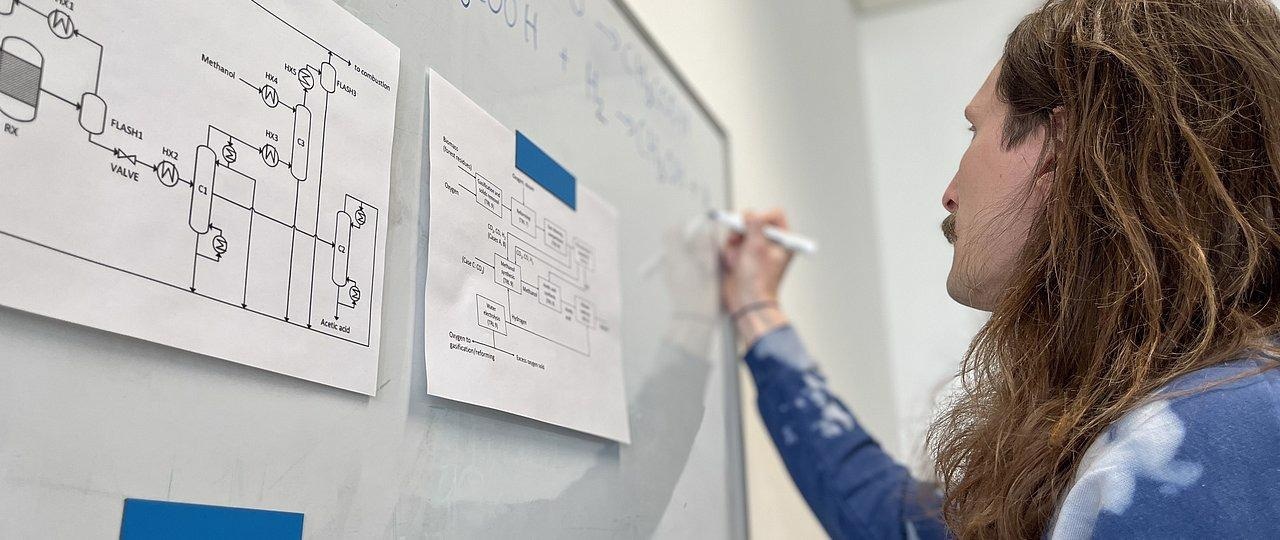There is a need to significantly decrease CO2 emissions to restrict the impacts of climate change. This is in accordance with the latest assessment report from the Intergovernmental Panel on Climate Change.
 In collaboration with the Lappeenranta-Lahti University of Technology (LUT) in Finland, researchers at the Straubing Campus for Biotechnology and Sustainability of the Technical University of Munich (TUM) have developed a new process for the production of ethanol. Image Credit: Maria Schießl / Technical University of Munich.
In collaboration with the Lappeenranta-Lahti University of Technology (LUT) in Finland, researchers at the Straubing Campus for Biotechnology and Sustainability of the Technical University of Munich (TUM) have developed a new process for the production of ethanol. Image Credit: Maria Schießl / Technical University of Munich.
One approach that could be adopted to decrease carbon emissions from the area of transportation is by producing fuel from renewable sources like waste wood and straw or renewable electricity. This is an area that is being addressed by scientists at the Technical University of Munich (TUM).
Generally, the production of ethanol has been done via the fermentation of sugars from starchy raw materials like corn, or lignocellulosic biomass, like straw or wood. It is a fixed fuel that tends to decarbonize the transportation sector and could be a building block in decreasing CO2 emissions over a long period.
Having collaborated with the Lappeenranta-Lahti University of Technology (LUT) in Finland, scientists at the Straubing Campus for Biotechnology and Sustainability of the Technical University of Munich (TUM) have come up with a new process for ethanol production.
In this regard, offcut materials from the area of forestry are utilized collectively with hydrogen. The hydrogen has been produced by splitting up water into hydrogen and oxygen using electricity (with the use of water electrolysis). In the forthcoming days, this will enable surplus electricity to be utilized for ethanol production.
The overall process mainly consists of technically mature sub-processes. However, the composition of the process steps and the final step – the hydrogenation of acetic acid to produce ethanol – are new.
Daniel Klüh, Doctoral Student, Professorship of Renewable Energy Systems, Technical University of Munich
The Costs of Ethanol with The New Production Method are Competitive
Furthermore, scientists evaluated economic efficiency.
The prices we have calculated are based on assumptions for raw materials and energy. We are not using any current market prices. The calculation basis of our prices for the components in the chemical system is the year 2020.
Daniel Klüh, Doctoral Student, Professorship of Renewable Energy Systems, Technical University of Munich
The minimum charges for ethanol in the modeling were 0.65 euros per liter, consisting of electricity costs of 45 euros per megawatt-hour, biomass costs of 20 euros per megawatt-hour, and a production volume of around 42 kilotons of ethanol annually.
With the current lignocellulosic ethanol production options, the costs are therefore competitive. The price of ethanol is very sensitive to the costs of electricity, and fluctuates between 0.56 and 0.74 euros per liter.
Kristian Melin, Assistant Professor, Lappeenranta-Lahti University of Technology
One cause for the high profitability is that the yield of ethanol is much greater than the conventional fermentation-based bioethanol process from wood or straw. This process generates 1350 to 1410 L of ethanol than just 200 to 300 L of ethanol for the conventional process per dry ton of biomass.
Where Production Facilities could be Located
Part of the study is concentrating on the variable geographical positioning of production sites, thereby allowing a degree of independence from suppliers to be obtained.
“Countries with a high potential for waste wood and green electricity, such as Finland or even Canada, can serve as producers of acetic acid, which, in the final process step, is hydrogenated to produce ethanol,” explained Professor Tuomas Koiranen of LUT.
“In the future, countries like Germany will hopefully have a green electricity mix and will be able to carry out the hydrogenation of acetic acid to ethanol at a domestic level. However, Germany does not have the waste wood potential for a large-scale biomass gasification which is required for the synthesis of acetic acid,” added Professor Matthias Gaderer, Professor of Renewable Energy Systems at TUM.
The Technology Needs to Mature Further
Using green electricity to power the electrolysis, this process could generate a low CO2 fuel consisting of a greenhouse gas reduction potential of 75% in contrast with a fossil fuel such as gasoline.
Ethanol has been established as a fuel. It could be utilized in the form of both E-10 gasoline, with 10% ethanol in the fuel mixture for regular automobiles, as this was the case earlier, or as ED95, which is 95% ethanol, can be used as a diesel substitute for the transportation of bulky goods.
With the help of their process simulation, the researchers have illustrated the competitiveness of the process.
Professor Gaderer stated, “To commercialize this product, it is necessary to further improve the degree of technological maturity. The next steps could entail further catalyst developments, a reactor design, and the construction and operation of a pilot system.”
Journal Reference:
Melin, K., et al. (2022) Techno-Economic Evaluation of Novel Hybrid Biomass and Electricity-Based Ethanol Fuel Production. Frontiers in Energy Research. doi.org/10.3389/fenrg.2022.796104.